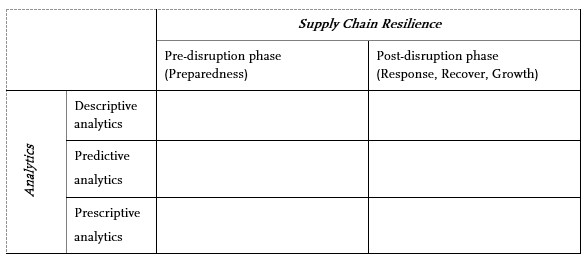Searching for a thesis project? Apply to DARe!
Are you interested in working on real-world challenges and get direct access to Swedish firms? If so, you should consider applying to one of the thesis projects within AFAIR’s new research project DARe. We’ve got five spots available in collaboration with Bufab, GKN, Thule, Siemens Energy and Thule.
Interested? Then you are welcome to contact Martin Seif martin.seif@ju.se immediately as the positions will be filled on a rolling basis.
The project “Data-Analytics for Resilience” (DARe) is planned to run during 2025 and 2026. DARe aim to focus on data-driven decision-making (analytics) before, during, and after disruptions. Decision-makers in logistics, procurement, or supply chains face challenging decisions during these disruptions, where quick and effective decisions can be crucial to maintaining the company's operations. Decision-making in connection with these disruptions is characterized by high complexity, as many parameters and other partners in the supply chain need to be considered, along with high dynamism and uncertainty. Collectively, these factors make decision-making highly demanding, which highlights the importance of good decision support. With this as the starting point, SCR illustrates interesting application area for analytics.
Thesis projects
Below are the descriptions of five thesis projects offered in DARe. Depending on your interest, you may apply for one or more of the projects. All projects will be hosted by one of the industrial partners, but with the opportunity of using the other partners in your thesis project, e.g., as benchmarking companies. The thesis project can be carried out in either Swedish or English.
1. Developing a Checklist or Contingency Plan for Effective Response to Supply Chain Disruptions – hosted by Thule.
While many firms reactively respond to these crises, there is a need for a structured, proactive approach to guide decision-making and actions once a disruption has occurred. The primary aim of this thesis should be to develop a comprehensive checklist or contingency plan that firms can follow when disruptions arise. This plan should provide actionable steps on critical decisions, tools to use, and guidelines on effective response mechanisms. The framework will aim to minimize response time, optimize resource allocation, and ensure business continuity during supply chain disruptions.
2. Retrospective Analysis of Task Force Operations During Supply Chain Disruptions and Development of Best Practice – hosted by Siemens Energy.
During supply chain disruptions, companies often form task force groups to manage the crisis. However, the effectiveness of these task forces can vary depending on the competencies represented and the decisions made during the crisis. There is a need to analyze past task force operations to identify key success factors and areas for improvement. This thesis should aim to analyze how task force groups have operated during previous supply chain disruptions. The study could for instance focus on the competencies represented, decision-making processes, utilized tools, and outcomes. Based on this analysis, the goal is to develop a best practice framework for forming and operating task forces in the event of future supply chain disruptions.
3. Classification of Supply Chain Disruptions – hosted by Bufab.
Supply chain disruptions come in various forms, from natural disasters to geopolitical crises. However, the classification of these disruptions is often inconsistent, making it difficult to develop targeted response strategies. A structured taxonomy could help firms understand different types of disruptions and tailor their response strategies more effectively. The objective of this research is to develop a classification scheme for supply chain disruptions, based on key characteristics such as cause, scope, duration, impact, and so on. This classification will provide a structured approach for companies to assess risks and develop more customized mitigation and response plans.
4. Current state assessment and identification of analytics applications for Supply Chain Resilience – hosted by GKN.
In previous research activities, the matrix illustrated below was developed, which shows that analytics applications for SCR can principally be divided into six different categories depending on the level of sophistication of analytics (descriptive, predictive, or normative) and in what phase it is used (before or after the disruption has occured). With the matrix and the six different categories as a starting point, a suitable continuation is to map what categories or specific applications that are currently used. The next step involves identifying/generating suggestions of analytics applications and investigating when and how they can be used, considering the companies' unique context and needs. Which of the six categories is more valuable and which are particularly problematic to develop and use in practice? Could it be that a specific application category is more desirable but also more difficult to realize in practice?

5. Strategies to overcome obstacles for the use of analytics for supply chain resilience – inhouse at JTH.
In previous research activities, we have identified multiple obstacles for using analytics for supply chain resilience. These include,
- Low data availability and/or quality
- Hindrance to quick decision making
- Lack of a data-driven culture
- Insufficient benefits and/or use
Based on these insights, a continuation would be to investigate potential strategies for overcoming (reducing or even eliminating) these barriers. In this way, analytics would become much more viable and attractive for developing supply chain resilience.


